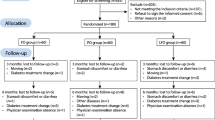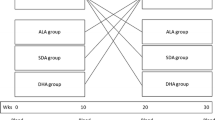Abstract
Based on mechanistic and epidemiological data, we raise the question of the relationship between qualitative dietary polyunsaturated fatty acids (PUFA) changes and increase in obesity. In this double-blind trial, we studied the effects on 160 overweight volunteers (body mass index, BMI >30) of a 90 days experimental diet rich principally in animal fat with a low PUFA/saturated fatty acid (SFA) ratio but a low n-6/n-3 ratio, using animal products obtained from linseed-fed animals. The control diet provided less animal fat, a higher PUFA/SFA ratio and a higher n-6/n-3 ratio. Both diets excluded seafood. In the experimental group, we observed a significant increase in red blood cell (RBC) α-linolenic acid content and a slight increase in EPA and DHA derivatives, while in the control group we observed a significant reduction in EPA and DHA content. Between groups now, the difference in the three n-3 fatty acids changes in RBC was significant. This demonstrates that plasma EPA and DHA levels can be maintained without fish if products from linseed-fed animals are used. During the diets, we noted a significant reduction in weight, BMI and hip circumference within both groups of volunteers. However, no significant difference was observed between the control group and the experimental group. Interestingly, 150 days after the end of the trial (i.e., day 240), we noted a significant weight gain in the control group, whereas no significant weight gain was observed in the experimental group. This was also observed for the BMI and hip circumference. Moreover, significant differences in BMI (P < 0.05) and weight (P = 0.05) appeared between the two groups, showing in both cases a smaller increase in the experimental group. During the 90 days trial, we did not observe any differences between groups in terms of total cholesterol, HDL cholesterol, LDL cholesterol or triglycerides, suggesting that the saturate content and the P/S ratio are not as important as the n-6 and n-3 fatty acid composition.
Similar content being viewed by others
Abbreviations
- BMI:
-
Body mass index
- PUFA:
-
Polyunsaturated fatty acids
- FA:
-
Fatty acid
- SFA:
-
Saturated fatty acid
- LNA:
-
Linoleic acid
- ALA:
-
α-Linolenic acid
References
Massiera F, Saint-Marc P, Seydoux J, Murata T, Kobayashi T, Narumiya S, Guesnet P, Amri EZ, Negrel R, Ailhaud G (2003) Arachidonic acid and prostacyclin signaling promote adipose tissue development: a human health concern? J Lipid Res 44:271–279
Ailhaud G, Guesnet P (2004) Fatty acid composition of fats is an early determinant of childhood obesity: a short review and an opinion. Obes Rev 5:21–26
Dayton S, Hashimoto S, Dixon W, Pearce ML (1966) Composition of lipids in human serum and adipose tissue during prolonged feeding of a diet high in unsaturated fat. J Lipid Res 7:103–111
Ailhaud G, Massiera F, Weill P, Legrand P, Alessandri JM, Guesnet P (2006) Temporal changes in dietary fats: role of n-6 polyunsaturated fatty acids in excessive adipose tissue development and relationship to obesity. Prog Lipid Res 45:203–236
Ailhaud G, Guesnet P, Cunnane SC (2008) An emerging risk factor for obesity: does disequilibrium of polyunsaturated fatty acid metabolism contribute to excessive adipose tissue development? Br J Nutr 100:461–470
Feskens EJ, Bowles CH, Kromhout D (1991) Inverse association between fish intake and risk of glucose intolerance in normoglycemic elderly men and women. Diabetes Care 14:935–941
Feskens EJ, Virtanen SM, Rasanen L, Tuomilehto J, Stengard J, Pekkanen J, Nissinen A, Kromhout D (1995) Dietary factors determining diabetes and impaired glucose tolerance. A 20-year follow-up of the Finnish and Dutch cohorts of the seven countries study. Diabetes Care 18:1104–1112
Nkondjock A, Receveur O (2003) Fish-seafood consumption, obesity, and risk of type 2 diabetes: an ecological study. Diabetes Metab 29:635–642
Garaulet M, Perez-Llamas F, Perez-Ayala M, Martinez P, de Medina FS, Tebar FJ, Zamora S (2001) Site-specific differences in the fatty acid composition of abdominal adipose tissue in an obese population from a Mediterranean area: relation with dietary fatty acids, plasma lipid profile, serum insulin, and central obesity. Am J Clin Nutr 74:585–591
Wang H, Storlien LH, Huang XF (2002) Effects of dietary fat types on body fatness, leptin, and ARC leptin receptor, NPY, and AgRP mRNA expression. Am J Physiol Endocrinol Metab 282:E1352–E1359
Baillie RA, Takada R, Nakamura M, Clarke SD (1999) Coordinate induction of peroxisomal acyl-CoA oxidase and UCP-3 by dietary fish oil: a mechanism for decreased body fat deposition. Prostaglandins Leukot Essent Fatty Acids 60:351–356
Simopoulos A (2001) n-3 Fatty acids and human health: defining strategies for public policy. Lipids 36:S83–S89
Astorg P, Arnault N, Czernichow S, Noisette N, Galan P, Hercberg S (2004) Dietary intakes and food sources of n-6 and n-3 PUFA in French adult men and women. Lipids 39:527–535
Guesnet P, Antoine JM, Rochette de Lempdes JB, Galent A, Durand G (1993) Polyunsaturated fatty acid composition of human milk in France: changes during the course of lactation and regional differences. Eur J Clin Nutr 47:700–710
Guesnet P, Couet C, Alessandri JM, Antoine JM, Durand G (1995) Variabilité de la teneur en acide linoléique (18:2n-6) et du rapport 18:2n-6/18:3n-3 des lipides dans le lait de femme en France. Ann Pédiatr 42:289–294
Dubnov G, Berry EM (2004) Omega-6 fatty acids and coronary artery disease: the pros and cons. Curr Atheroscler Rep 6:441–446
Combe N, Boué N (2001) Apports alimentaires en acides linoléique et alpha-linolénique d’une population d’Aquitaine. Oléagineux Corps gras Lipides 8:118–121
Weill P, Schmitt B, Chesneau G, Daniel N, Safraou F, Legrand P (2002) Effects of introducing linseed in livestock diet on blood fatty acid composition of consumers of animal products. Ann Nutr Metab 46:182–191
Friedwald WT, Levy RI, Fredrickson DS (1972) Estimation of the concentration of low-density lipoprotein cholesterol in plasma without use of the preparative ultracentrifuge. Clin Chem 18:499–502
Rioux V, Lemarchal P, Legrand P (2000) Myristic acid, unlike palmitic acid, is rapidly metabolized in cultured rat hepatocytes. J Nutr Biochem 11:198–207
Sands SA, Reid KJ, Windsor SL, Harris WS (2005) The impact of age, body mass index and fish intake on the EPA and DHA content of human erythrocytes. Lipids 40:343–347
Cao J, Schwichtenberg KA, Hanson NQ, Tsai MY (2006) Incorporation and clearance of omega-3 fatty acids in erythrocytes, membranes and plasma phospholipids. Clin Chem 52:2265–2272
Legrand P, Bourre JM, Descomps B, Durand G, Renaud S (2001) Lipides. In: Martin A, AFSSA-CNERNA-CNRS (eds) Apports nutritionnels conseillés pour la population française. Tec et Doc Lavoisier, Paris, pp 63–82
Brenna JT, Salem N, Sinclair A, Cunnane S (2009) Alpha-linolenic acid supplementation and conversion to n-3 long-chain polyunsaturated fatty acids in humans. Prostaglandins Leukot Essent Fatty Acids 80:85–91
Leblanc JC, Sirot V, Volatier JL, Bemrah-Aouachria N (2006) Etude des Consommations Alimentaires de Produits de la mer et Impregnation aux éléments traces, Polluants et Omega-3 (CALIPSO). AFSSA-INRA (ed), pp 1–160
Jenkins D, Sievenpiper J, Pauly D, Sumaila U, Kendall C, Mowat F (2009) Are dietary recommendations for the use of fish oils sustainable? CMAJ 180:633–637
Delarue J, Couet C, Cohen R, Brechot JF, Antoine JM, Lamisse F (1996) Effects of fish oil on metabolic responses to oral fructose and glucose loads in healthy humans. Am J Physiol 270:E353–E362
Couet C, Delarue J, Ritz P, Antoine JM, Lamisse F (1997) Effect of dietary fish oil on body fat mass and basal fat oxidation in healthy adults. Int J Obes Relat Metab Disord 1:7–43
Moussavi N, Gavino V, Receveur O (2008) Could the quality of dietary fat, and not just its quantity, be related to risk of obesity? Obesity (Silver Spring) 16:7–15
Storlien LH, Hulbert AJ, Else PL (1998) Polyunsaturated fatty acids, membrane function and metabolic diseases such as diabetes and obesity. Curr Opin Clin Nutr Metab Care 1:559–563
Hulbert AJ (2007) Membrane fatty acids as pacemakers of animal metabolism. Lipids 42:811–819
Micallef M, Munro I, Phang M and Garg M (2009): Plasma n-3 polyunsaturated fatty acids are negatively associated with obesity. Br J Nutr (in press). doi:10.1017/S0007114509382173
Turk MW, Yang K, Hravnak M, Sereika SM, Ewing LJ, Burke LE (2009) Randomized clinical trials of weight loss maintenance: a review. J Cardiovasc Nurs 24:58–80
Watts GF, Chan DC, Ooi EM, Nestel PJ, Bellin LJ, Barrett PH (2006) Fish oils, phytosterols and weight loss in the regulation of lipoprotein transport in the metabolic syndrome: lessons from stable isotope tracer studies. Clin Exp Pharmacol Physiol 33:877–882
Ng TW, Watts GF, Barrett PH, Rye KA, Chan DC (2007) Effect of weight loss on LDL and HDL kinetics in the metabolic syndrom: associations with changes in plasma retinol-binding protein-4 and adiponectin levels. Diabetes Care 30:2945–2950
Chan DC, Watts GF, Ng TW, Yamashita S, Barrett PH (2008) Effect of weight loss on markers of triglyceride-rich lipoprotein metabolism in the metabolic syndrome. Eur J Clin Invest 38:743–751
Ueki K, Sakurai N, Tochikubo O (2009) Weight loss and blood pressure reduction in obese subjects in response to nutritional guidance using information communication technology. Clin Exp Hypertens 31:231–240
Knopp RH, Retzlaff BM (2004) Saturated fat prevents coronary artery disease? An American paradox. Am J Clin Nutr 80:1102–1103
Chan JK, Bruce VM, McDonald BE (1991) Dietary alpha-linolenic acid is as effective as oleic acid and linoleic acid in lowering blood cholesterol in normolipidemic men. Am J Clin Nutr 53:1230–1234
Author information
Authors and Affiliations
Corresponding author
About this article
Cite this article
Legrand, P., Schmitt, B., Mourot, J. et al. The Consumption of Food Products from Linseed-Fed Animals Maintains Erythrocyte Omega-3 Fatty Acids in Obese Humans. Lipids 45, 11–19 (2010). https://doi.org/10.1007/s11745-009-3376-5
Received:
Accepted:
Published:
Issue Date:
DOI: https://doi.org/10.1007/s11745-009-3376-5




